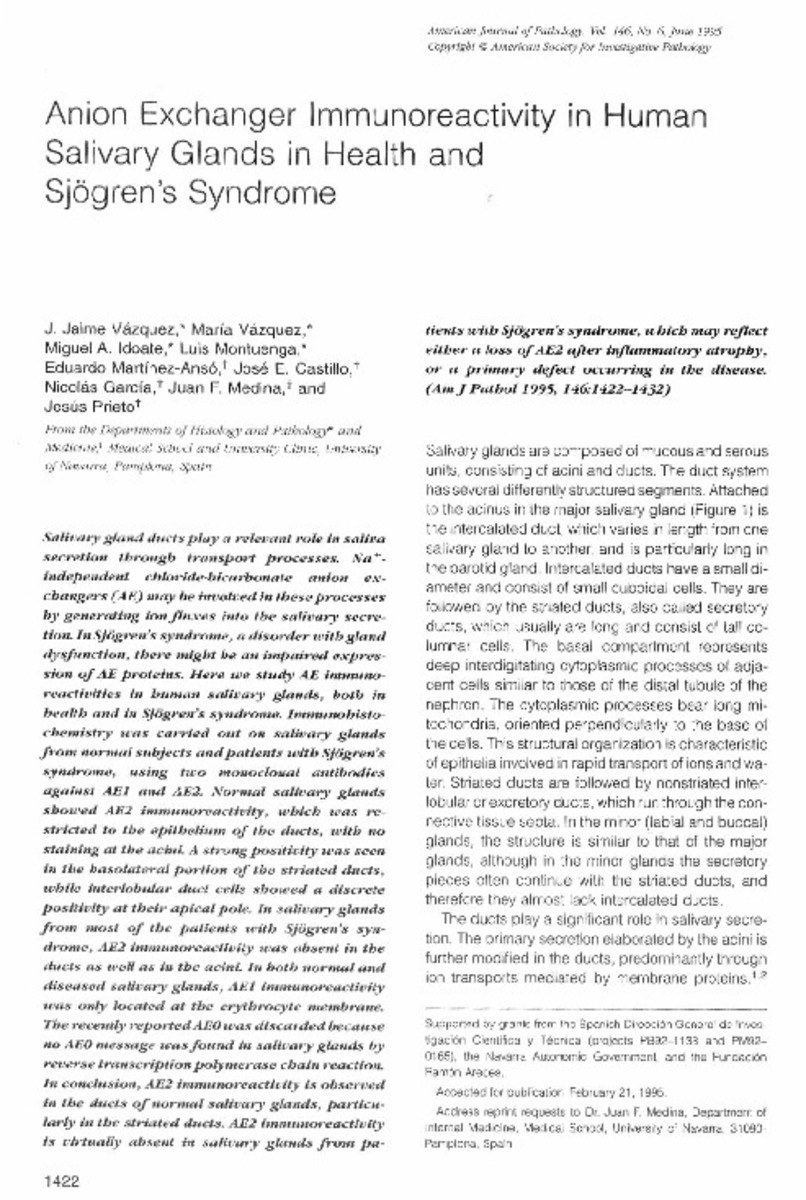Full metadata record
| DC Field | Value | Language |
|---|---|---|
| dc.creator | Vazquez, J.J. (Jesús Jaime) | - |
| dc.creator | Vazquez, M. (María) | - |
| dc.creator | Idoate, M.A. (Miguel Ángel) | - |
| dc.creator | Montuenga-Badia, L.M. (Luis M.) | - |
| dc.creator | Martinez-Anso, E. (Eduardo) | - |
| dc.creator | Castillo, J. (José E.) | - |
| dc.creator | Garcia, N. (Nicolás) | - |
| dc.creator | Medina, J.F. (Juan Francisco) | - |
| dc.creator | Prieto, J. (Jesús) | - |
| dc.date.accessioned | 2011-12-05T11:28:50Z | - |
| dc.date.available | 2011-12-05T11:28:50Z | - |
| dc.date.issued | 1995 | - |
| dc.identifier.citation | Vazquez JJ, Vazquez M, Idoate MA, Montuenga L, Martinez-Anso E, Castillo JE, et al. Anion exchanger immunoreactivity in human salivary glands in health and Sjogren's syndrome. Am J Pathol 1995 Jun;146(6):1422-1432. | es_ES |
| dc.identifier.issn | 1525-2191 | - |
| dc.identifier.uri | https://hdl.handle.net/10171/20135 | - |
| dc.description.abstract | Salivary gland ducts play a relevant role in saliva secretion through transport processes. Na(+)-independent chloride-bicarbonate anion exchangers (AE) may be involved in these processes by generating ion fluxes into the salivary secretion. In Sjögren's syndrome, a disorder with gland dysfunction, there might be an impaired expression of AE proteins. Here we study AE immunoreactivities in human salivary glands, both in health and in Sjögren's syndrome. Immunohistochemistry was carried out on salivary glands from normal subjects and patients with Sjögren's syndrome, using two monoclonal antibodies against AE1 and AE2. Normal salivary glands showed AE2 immunoreactivity, which was restricted to the epithelium of the ducts, with no staining at the acini. A strong positivity was seen in the basolateral portion of the striated ducts, while interlobular duct cells showed a discrete positivity at their apical pole. In salivary glands from most of the patients with Sjögren's syndrome, AE2 immunoreactivity was absent in the ducts as well as in the acini. In both normal and diseased salivary glands, AE1 immunoreactivity was only located at the erythrocyte membrane. The recently reported AE0 was discarded because no AE0 message was found in salivary glands by reverse transcription polymerase chain reaction. In conclusion, AE2 immunoreactivity is observed in the ducts of normal salivary glands, particularly in the striated ducts. AE2 immunoreactivity is virtually absent in salivary glands from patients with Sjögren's syndrome, which may reflect either a loss of AE2 after inflammatory atrophy, or a primary defect occurring in the disease. | es_ES |
| dc.language.iso | eng | es_ES |
| dc.publisher | Elsevier | es_ES |
| dc.rights | info:eu-repo/semantics/openAccess | es_ES |
| dc.subject | Antiporters/immunology | es_ES |
| dc.subject | Salivary Glands/chemistry | es_ES |
| dc.subject | Sjogren's Syndrome/metabolism | es_ES |
| dc.title | Anion exchanger immunoreactivity in human salivary glands in health and Sjögren's syndrome | es_ES |
| dc.type | info:eu-repo/semantics/article | es_ES |
| dc.relation.publisherversion | http://www.ncbi.nlm.nih.gov/pmc/articles/PMC1870910/?tool=pubmed | es_ES |
Files in This Item:
Statistics and impact
Items in Dadun are protected by copyright, with all rights reserved, unless otherwise indicated.






